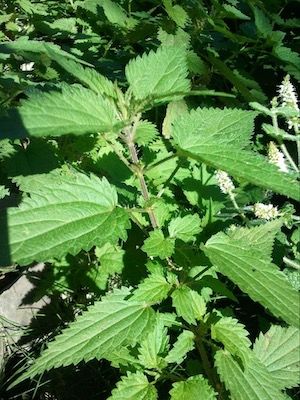Nettle
I- Nomenclature
Latin name: Urtica dioica
Family : Urticaceae
Common names: Common nettle, stinging nettle, nettle leaf1
Etymology
from the Latin "Urtica" "urere": to burn
from Latin "dioica": dioecious
II- Legends and traditions
Nettle holds a great place in the popular traditions of the peoples of the Himalayas. Milarépa (1040-1123), the most revered saint by the Tibetans, owed his survival to him while he stayed in a cave for 12 years. Internally, he took the nature of the nettle (as he relates in his memoirs), externally, its skin and hairs turned green like a caterpillar, frightening passing hunters who at first took it for a ghost.
III- Botanical description
Description: Perennial herbaceous 60 to 150 cm high, forming colonies thanks to its long rhizomes. All of its organs are covered with two types of hairs: long stinging hairs and small flexible hairs. Its stems are erect and unbranched. The dark green, opposite leaves, oval to lanceolate, are usually twice as long as they are broad. They are lined with strong triangular teeth. The epidermal cells contain calcified corpuscles called cystoliths. The flowers are unisexual, tiny and united in clusters, male and female on different feet (dioecious form). The female clusters are drooping, the male clusters erect. The female flower is made up of 4 tepals, two of which are much larger enveloping a unilocular ovary and two outer ones. The male flower has 4 tepals and 4 stamens, curved into the bud and resiliently straightening at the anthesis, projecting a small cloud of pollen away. The pollination is anemophilous. The fruit is an ovoid achene, which remains enveloped in the two large accrescent tepals.
Habitat:
Nettle likes ruderalized wastelands, meadows, rubble and the surroundings of houses. It is a plant bioindicator of basic soils, rich in nitrogen, phosphorus and potassium. It signals an excess of organic matter or soil pollution by ferric oxides.
Harvest:
Leaves before flowering
Roots in autumn
Pars used : leaves and root
IV- Active ingredients
|
Leave |
Root |
|
Histamine, formic acid • acetylcholine • serotonin • mineral salts: Ca- K- Mg- P- Cu- Fe- Si -Zi • vitamins A, B, C, E |
• Tannins • Phytosterols and phenols |
V- Therapeutic uses
Properties
|
Internally |
Externally |
|
• Anti-diabetic • astringent • diuretic • galactogen • powerful hemostatic • tonic • vasoconstrictor |
Anti dandruffantipruritic anti-seborrheic |
Indications
Helps fix calcium tonsillitis, tonsillitis, oral and pharyngeal infections convalescence diabetes eczema, psoriasis, lichens skin rash, hives transient or chronic fatigue haemorrhages, too long periods, nosebleeds traditionally used for hair loss and dandruff
Dosage
Aerial parts
Infusion: transient or chronic fatigue, convalescence (association with horsetail), helps to fix calcium, diabetes: let the chopped nettle leaves boil slowly in 200 ml of water and drink it 3 times a day.
Decoction: eczemas, psoriasis, lichens: whole plant in decoction for 5min, 3 cups / day. - tonsillitis, tonsillitis, infections, buccopharyngeal: as a gargle. Tincture: Use in mixtures for arthritis, skin problems and heavy uterine bleeding.
Compress: Soak a gauze or cloth in the tincture and apply to aching joints with arthritis, gout, neuralgia, sprains, tendonitis and sciatica.
Ointment: apply to hemorrhoids.
Lotion: apply to burns, insect bites and wounds. Juice: Pass the whole fresh plant in a blender to make a good tonic for general weakness conditions like anemia and to relieve nettle stings. Prescribed in cases of heart failure with edema (under medical supervision).
Root Lotion: use a decoction to rinse the scalp in case of dandruff, hair loss and as a detangler.
Seeds
Decoction: purgative (do not exceed 12 seeds per day under penalty of causing a real intestinal breakdown).
VI- Precaution of use
Contraindication
Lithium treatment: bipolar disorder
in case of edema
pregnancy
VII- The suggestion box
Histamine and formic acid in the hairs are responsible for the stings associated with the plant.
Nettle leaves are a good tonic for anemia. The plant's high vitamin C content helps ensure that iron is properly absorbed by the body. They remove uric acid from the body and therefore help relieve symptoms of gout and arthritis. Their astringent effect stops bleeding.
1 https://en.wikipedia.org/wiki/Urtica_dioica



